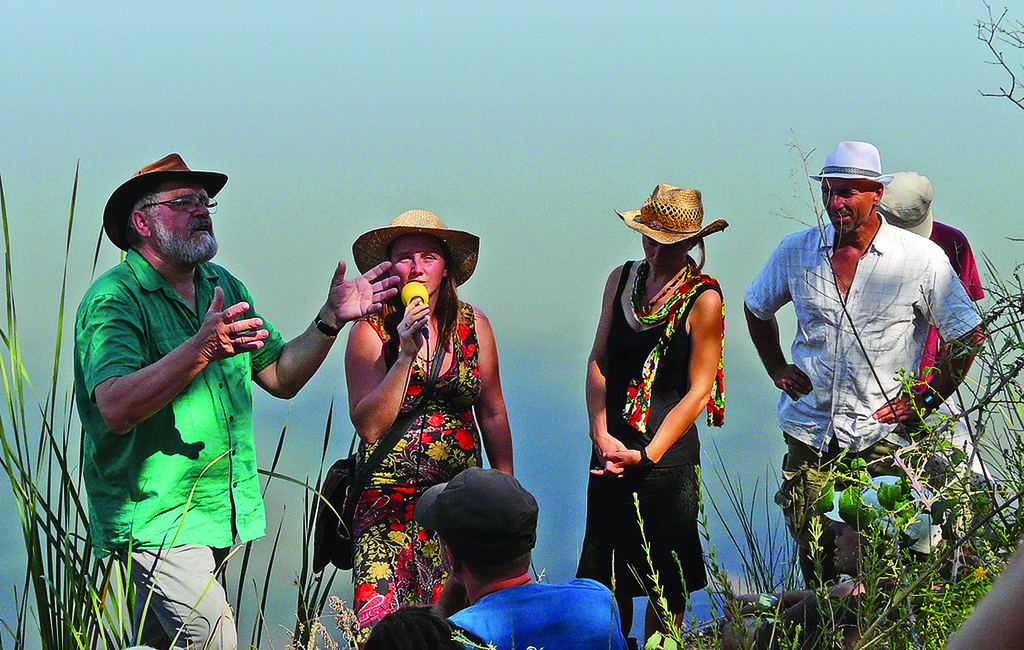Droughts, desertification, heat waves, floods: the consequences of climate change are intensified by a water balance that is out of equilibrium globally. In some parts of the earth, farmers, different initiatives and landowners are meeting this challenge with simple, local measures – and successfully. The principle they follow is always the same: rain should seep into the ground where it falls. Decentralisation instead of centralisation. One successful example of this is Tamera, in the municipality of Odemira in the Alentejo.

Every organism needs water. Whether an area has sufficient water or not determines its value for everything that lives there, be it humans, animals or plants. A region with sufficient water has ecological and social resilience; in other words it is better able to resist ecological, economic and social crises, as well as extremes of weather. This was the experience of the inhabitants of the district of Thanagazi Tehsil near the Thar Desert in Rajasthan/India. Where women once had to walk long distances with their buckets, today they only need to go to the village well. Men who went in search of work all over India are once again working in agriculture and trades in their own village. Five dried-up rivers in an area of 6,500 square kilometres are flowing once again. Around a thousand villages have water again. Forests are growing again, the agricultural harvest has increased fivefold. The man who brought all this about is known to everyone simply as the “Water-Gandhi”: Rajendra Singh, aged 58 and a doctor. He realised that the cause of many illnesses was a lack of water and he launched a popular movement. Using several thousand traditional, simple, decentralised dams made of stones and gravel, known as johads, villagers were able to stop the rainwater draining away so fast. Rajendra Singh was awarded the renowned Stockholm Water Prize for his achievements.
 Dr. Singh is part of a small but globally networked group that seeks to mitigate the effects of climate change through regenerative water management. They call it the “new water paradigm”. Whether it’s desert, mountains or a coastal region, the principle is always the same: rain should be able to infiltrate into the ground where it falls, in a decentralised manner, in as many places as possible. The model for this is a healthy mixed forest with humus-rich soil. It acts like a sponge: vegetation and soil absorb the rainwater completely and then release it again slowly. The water evaporates, new clouds form, and it rains again: in this way, regional rainwater cycles come into being that spread across the country and carry the precious moisture into the next region. Nature’s water distribution system is perfect.
Dr. Singh is part of a small but globally networked group that seeks to mitigate the effects of climate change through regenerative water management. They call it the “new water paradigm”. Whether it’s desert, mountains or a coastal region, the principle is always the same: rain should be able to infiltrate into the ground where it falls, in a decentralised manner, in as many places as possible. The model for this is a healthy mixed forest with humus-rich soil. It acts like a sponge: vegetation and soil absorb the rainwater completely and then release it again slowly. The water evaporates, new clouds form, and it rains again: in this way, regional rainwater cycles come into being that spread across the country and carry the precious moisture into the next region. Nature’s water distribution system is perfect.
It is only when forests are cut down and replaced with monocultures, when land surfaces are sealed off, rivers are straightened and dammed, when grasslands are overgrazed, when the ground hardens and absorbs no more water, that a region becomes vulnerable. This leads to all the consequences that are known as climate change: heavy rainfall washes valuable soil away, rivers burst their banks, water tables drop, sea levels rise, dry periods become longer. Both floods and desertification are a consequence of mishandling water and the land.
The meteorologist Prof. Millan Millan from Valencia has confirmed this through the gathering of data over decades: while searching for the causes of the changes in rain patterns throughout Europe he hit upon the destruction of the small water cycles through deforestation, soil sealing and overgrazing. His recommendation for climate protection: built-up areas should be turned back into biotopes that are conducive to rainfall and are rich in different species.
Examples from Australia to Zimbabwe
Where forests have been destroyed, measures can be taken to replace their functions for a while in line with the new water paradigm – until the forest grows again. A wide range of examples of this come from all over the world.
“People and Water” – this was the name of the project by hydraulic engineer Michal Kravcik to activate people from 488 towns and villages in Slovakia. In 18 months, they built around 100,000 small “checkdams” made of stones and wood in a degraded region. They don’t store the water, but slow it down. The result is that the land became fertile again. Agriculture and the forests flourished. There was no need to build a large-scale dam that had been planned.
In Australia, as early as the 1950s, the farmer and engineer P. A. Yeomans invented the Keyline System: by creating many parallel furrows along the contour lines of a site using a special plough, the flow of rainwater is slowed down. Even heavy rain is absorbed by the ground. This reduces erosion significantly, and valuable topsoil forms in the ditches. The system is applied nowadays by permaculture activists and landowners in Portugal too.
Another experience comes from Zimbabwe: Allan Savory studied the grazing patterns of herds of migrating wild animals. He knew that antelopes, zebras and other grazing animals improve the water storage capacity of grasslands. By treading the grasses into the ground during short but intensive grazing and fertilising the ground with their dung, the biomass decomposes more quickly and water-absorbing humus is formed. By contrast, herds of farm animals stand on the land for longer and harden it with their steps. Rainwater flows off, the ground erodes and becomes impoverished. Savory developed holistic grazing management, a grazing system managed by flexible fences, which follows the grazing patterns of herds of wild animals: intensive but short. As 40% of the planet’s land mass consists of grasslands, many see grazing management as the most efficient and cost-effective way of improving the global water situation.
In cities too, the new water paradigm is being applied: in Los Angeles, Andy Lipkis is building housing developments with a green infrastructure. With gardens, ditches, tree planting, the use of service water and the collection of rainwater, these demonstrate in an exemplary manner that even a metropolitan desert like Los Angeles can reduce its water consumption sharply.
The Tamera international community in the Alentejo successfully combines several of these ideas: in 2007, with the guidance of the eco-visionary Sepp Holzer from Austria, the community started building a water retention landscape. The 150 hectare site used to be dry in the summer, but is now dotted with countless lakes, ponds and ditches, fed purely by the winter rains. No concrete and no plastic sheeting were used: the aim is just to slow the water down so that it can seep into the ground. The area has changed enormously: several thousand fruit trees are growing on terraces. Gardening can be done all year round. Countless wild animals have reappeared, including storks and otters. With its water retention landscape, Tamera is a widely respected model for decentralised water management in a country that is threatened by desertification and forest fires. The person in charge of the water retention landscape at Tamera, Bernd Müller, travels throughout the world to advise landowners and aid organisations on this technique, in crisis areas too.
Tamera: www.tamera.org
Andy Lipkis: www.treepeople.org
Allan Savory: www.savory.global
Sepp Holzer: www.seppholzer.at
P. A. Yeomans: yeomansplow.com.au
 Eco123 Revista da Economia e Ecologia
Eco123 Revista da Economia e Ecologia

